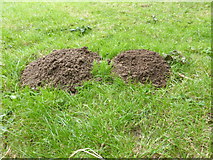Things growing in my lawn
I have three areas of grass in my garden. A small front garden, a conventional back garden, and a further area we call 'the orchard' because I planted apple trees. This rear section was bought separately from the developers, and although other householders have extensively cultivated theirs, mine has never been disturbed apart from planting some apple trees and cutting the grass. The soil and the grass cover are directly descended from the original 'West Field', a stray meadow and grazing used overnight for beast headed to Bourne Market. Although my mowing must have had some effect I do it fairly infrequently and it probably closely resembles the 19th century grazing.
![]()
![]()
Thus there are things growing in the grass that were probably there a hundred years ago. I think that has some geographic merit. The soil is part of a narrow irregular strip along the edge of the fens that the British Geological Survey describes as "Kellaways Clay Member - Mudstone". It is a heavy but fertile clay, frequently waterlogged in winter. Within a few metres are the lighter soils of Bourne Woods and the hills toward Edenham, which are similarly sedimentary, and described as "Kellaways Sand Member - Sandstone And Siltstone, Interbedded." This is the very edge of the Lincolnshire Limestone, sloping down below the fens.
Both geologies are said to be "Sedimentary Bedrock formed approximately 161 to 165 million years ago in the Jurassic Period".
The garden is just above the 25metre contour.
I can't identify the grasses. There are loads. I can, however, manage the flowering plants.
![]() Bellis perennis, the Common Daisy.
Bellis perennis, the Common Daisy.
This is a fantastically widespread plant of grassland, with a flowering season from late spring to early autumn. The flower closes at night, leading to the suggestion that the common name is a corruption of 'Days Eye', which seems a bit contrived to me. At one time children would spend hours constructing Daisy Chains, but the habit seems to have died out.
![]() Ranunculus repens, Creeping Buttercup
Ranunculus repens, Creeping Buttercup
This is a very invasive plant, but I can forgive it because of the spectacular colour of the flowers. There are various buttercups, but the foliage rather than the flower is the method of identification.
![]() Linum bienne, Pale Flax
Linum bienne, Pale Flax
This is a rather intermittent flowerer, but will come back after a couple of years when I havn't seen it. The stem has very thin leaves.
![]() Anagallis arvensis, Scarlet Pimpernel
Anagallis arvensis, Scarlet Pimpernel
Normally an indicator of light soils, this is quite well established in my clay. The plant has had over names, such as Shepherd's Weather Glass, because the flower only opens under the brightest of skies. On a sunny day it opens around 9am and closes around 4pm, but on a dull day it might not open at all.
![]() Medicago lupulina, Black Medick
Medicago lupulina, Black Medick
One of the tiny plants known as Hop Clover, this is a useful plant in a lawn as it is a nitrogen fixer: to the extent that it is an indicator of nitrogen-poor soil. It has invaded within the last 15 years, suggesting that the heavy water-logging of recent cold wet winters have finally leached out all trace of the 19th century cattle population on the land.
![]() Prunella vulgaris, Selfheal
Prunella vulgaris, Selfheal
This is my favourite of all the things I run the mower over. The popular name recalls its former use in wound healing. When I was at school I was told that Roman Legionaries carried it in their pack and planted it wherever they went, and that it is a sure indicator of former Roman occupation.
I was disappointed when researching for this blog that this notion is not mentioned in any quotable text.
![]() Trifolium pratense, Red Clover
Trifolium pratense, Red Clover
![]() Trifolium repens, White Clover
Trifolium repens, White Clover
A well-known constituent of grazing land, high in protein for the cattle and always buzzing with bees when the sun shines. I love the sight of clover in bloom.
![]() Myosotis arvensis, Common Forget-me-not
Myosotis arvensis, Common Forget-me-not
Precursor of a thousand garden varieties, the tiny blue stars of Forget-me-not are a constant joy.
---
Update in 2020. I have members of the club to report
![]() Cardamine pratensis, The Cuckoo Flower or Ladysmock
Cardamine pratensis, The Cuckoo Flower or Ladysmock
![]() Euphorbia helioscopia, The Sun Spurge.
Euphorbia helioscopia, The Sun Spurge.
There are blocks of these in the nearby woodland, and this one is sheltering in the shade of a fencepost
![]() Stellaria holostea, Greater Stitchwort
Stellaria holostea, Greater Stitchwort
I had been told this was a garden planing, called "Snow in Summer" (Cerastium tomentosum), until I took a little more notice. It is the Greater Stitchwort.
![]() Veronica serpyllifolia, the Thyme-leaf Speedwell
Veronica serpyllifolia, the Thyme-leaf Speedwell
A tiny flower, around 3mm across at most. It spreads across the lawn most years, but is not visible every year. The plant is not easy to discern when it is not flowering, hidden in the grass.
- When
- Sun, 5 Jul 2015 at 09:49
- Grid Square
 TF0820
TF0820- Chosen Photo
blog comments powered by Disqus

